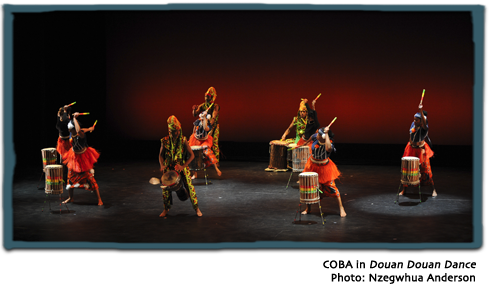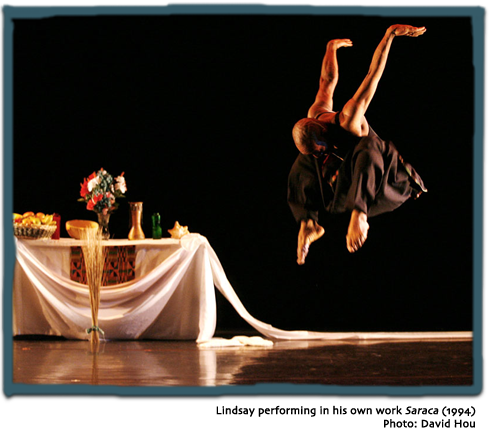CA: I have a question, BaKari. You often used to make all the costumes for your work. Do you still do this?
BL: Yes, I still do. It's a big part of the creative process. When I begin a work, I see everything. It's a skill and a talent that I have and it just works for me to build the costumes.

CA:: So that's part of the whole concept of the work ...
BL: Yes, it's part of the whole thing. Sometimes I see the costumes first, before I even see the work.
This whole piece is called Inner Voice. Sometimes we say to ourselves, “If I had only listened to myself I would have done so and so.…” The piece plays with that notion of trusting the unknown. We considered several costume ideas and eventually, I think, because the piece was so abstract for the viewer, and contained so many ideas, I thought if I wore a business suit, which is part of our lives, it would be clear. A lot of people in the general public can identify with a suit, and it would give the public something to hold onto; I wanted to give the audience something to get them centred.
Some people got it and some didn't. Originally it was supposed to be an entire business suit. The first time I did it, the suit just didn't feel right for the piece; so I took the pants off and turned the jacket inside out. We did a test run of it at Dance Weekend and I actually made the decision two seconds before I walked onstage. So sometimes that's how the decision is made; and sometimes it's a long, very gruelling process of me shopping for fabric and not liking the fabric and all that.
CA: So you still have time to do that too?
BL: Oh yes, I still do. I think it's fun.
Q: I have two questions. One is about the music and how you find that the traditional music has had to evolve along with your dance.
BL: It's interesting that you ask that question because the composer of the music for Inner Voice, Eddi di Fanti, is actually Senegalese and is a traditional drummer. The title of his piece is called Djembe, which drew me to the music. I was searching for contemporary African composers, and this whole CD is called Djembe in C. He paired up with Terry Reilly, which got me really intrigued. I was very curious about what it would sound like – so I was drawn to the music by its traditional title, and that's how I found this piece.
Sometimes I begin with music and sometimes I add music later. I have choreographed entire pieces, sixty minutes, and put music on later. The dancers hate me for this, because within one given choreographic process I can change the music fifty times. During one period they would come to rehearsal, I would put the music on, and say, “Okay, let's go” and that would be the first time they had heard the music. They would groan, “It's different.” And I would say, “Keep going.”
Sometimes they would say, “Oh, we like this one better” and as soon as they'd get liking it, I would switch. I'm curious about whether they are genuinely engaging in the physicality; or are they, at some points, getting used to the music and then letting the music propel the movement? So I'm always pushing them to be honest to the physicality. When we create the work, they are always excited about the physicality, but once you give them a piece of music, depending on the quality of the music, then the physicality starts to be influenced by the music. Unless we are finally getting close to performance, I change the music a lot, go to extremes. Sometimes I throw a full classical aria on and say, “See what happens and I don't want the quality to change.” See what happens and really force them to dig in and be honest and genuine to the physicality that I want.
I rarely count, which is another thing that annoys dancers, because they like to. And it makes it hard to rehearse. I give rhythmic phrases or particular rhythmic patterns that they have to adhere to. Sometimes, depending on the piece of music, the rhythm pattern gets lost and that is a bone of contention with me.

Q: I'm just wondering ... are you saying that each performance is different?
BL: It depends on the work. I mean by the time it hits the stage it gets very formal because of the nature of performance and staging, and it's funny how quickly dancers learn patterns. Even the most abstract of works becomes very formal and structured because as dancers, in our training, we learn formality.
It's funny that you ask that question because even in traditional West African dance music is not counted. The musicians lead. After a while you can almost tell when the musician is going to bring that break in. Even with those works, you build up a rhythm and you can almost guarantee that the rhythmic changes will come within a ballpark. So again, it's the nature of how we live, in the context of the world in which we exist, and it seeps into our creative process and our delivering of work, and even though we would love to be able to have this feeling of freedom and fluidity of work, it never happens. It may happen for the first performance but once that works, good, that works, and we'll do it that way the following night. It's a battle trying to get performers to be as fluid as possible. Sometimes it happens wonderfully and you say “Wow!” and then they package it, and try to create the wow every night.
Q: Could you talk about COBA a bit? You often have musicians …

home l shop dcd l history l links l donations l the collection l services l shipping policy l CIDD l exhibitions l CDFTP
educational resources l visits & lectures l making archival donations l grassroots archiving strategy l personnel l RWB alumni


